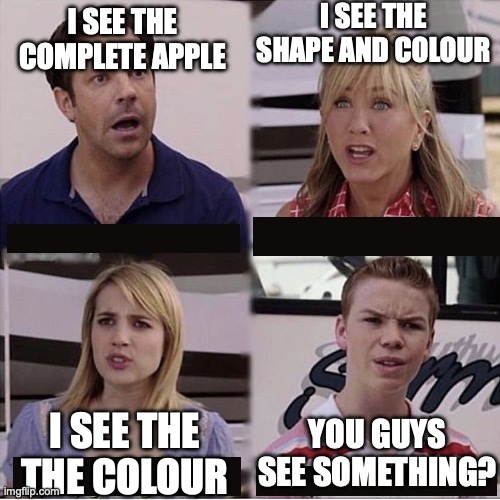The brain is a funny thing. Since we can’t see into each others brains (well, without the help of MRIs, etc. – not the average equipment people have laying around), we’re often reliant on trusting a shared frame of reference when talking to one another. When two people are discussing an apple for instance without any other frame of reference, are they both thinking of the same type of apple? Conceptually they’re certainly both talking about an apple, but for one person maybe an apple is lusciously red but the other it’s vividly green.
It’s just one aspect of where philosophy goes into when it dives into subjective vs objective knowledge. Indeed, you might say that one of the more extreme forms of philosophical debate around subjective vs objective knowledge can be found in solipsism (briefly, and skipping over nuance: the belief that you can only be certain about your own self and the existence of everything outside of you is unprovable).
Returning to the apple example – when we’re talking to each other we hope to be working from a shared frame of reference when discussing ideas and concepts. But if those ideas and concepts effectively sit exclusively within the operating environment of your brain, that shared frame of reference can be pretty subjective.
So — for all my life until this past week when I made the connection – when people have talked about “seeing things in their mind’s eye”, I thought the way I “saw “see” things in my mind’s eye is what they’re talking about.

It turned out that “seeing in your minds eye” is one of those truly subjective things that I’d never appreciated before. I’ve always used the expression. I’ve talked about one of the consequences of my speech impediment as a child, learning how to speak using flash cards with simple objects on them (home, cat, dog, and yes, even apple) is that I effectively “see” these things when I’m saying them.
But you folk actually mean “see” when you say it. Like, literally.
I have aphantasia.
When I close my eyes and try to visualise something – anything – it’s just darkness. What I always called “seeing” though in those situations is a rapid run through of the object properties. Apple? Red. Crunchy. Five-pointed bottom (if you’re lucky to get a decent apple). Little stalk poking up from the centre. All those things – I run through the properties in my head like a check list. I don’t see a thing. Even something as grotesquely simple as “close your eyes and imagine a square” gives me darkness – and again, a rapid run-through of the properties of a square. Yes, four lines, the end of each line touches another’s at a 90º angle and they form a perfectly bounded shape.
Now here’s an interesting pickle: here I am, having aphantasia and unable to visualise anything in my mind’s eye in the way most people talk about visualising in their mind’s eye (it’s estimated only 2-4% of the population has aphantasia), and one of my main areas of responsibility as a product manager is User Experience/User Interface.
How does that work?
Well, it turns out, I think it works quite well. Remember what I said about subjective vs objective interpretations of ideas earlier? If you’ve got two people discussing a visual concept, they both have an idea in their head of where that visual concept might go. Visually, that is.
But on that front, I don’t.
Instead, I have a list of thoughts about the overall properties of what I want. And by properties, I’m not really talking buttons and checkboxes and so-on, but objectives. Which, funnily enough, translate pretty well into typing out a list of requirements for UX/UI. And it means when someone who does have a visual concept of what they think it is starts explaining it to me, they’re speaking my language. They’re describing properties and elements and workflow, all the things I’ve been doing all my life in my head whenever I need to “imagine in my mind’s eye”. So suddenly we’re quite close to being on the same page.
Very occasionally when I’m struggling to get across my list-of-properties I might sit for a short while with Visio, OmniGraffle, even PowerPoint and play with shapes to refine my objectives, but it’s actually a rarity for me. I just want to list all the properties I’m thinking of and let the people who are the expert designers do the work. I’m not describing the how, but I am describing the what and the why. (Trust me, my husband has been a professional graphic designer – now an art director – for longer than I’ve known him. I have no illusions about my ability to do the work of a professional designer.)
Aphantastic UX? More like fantastic UX. The brain isn’t just a funny thing, it’s a crazy adaptable thing. It doesn’t matter what you can see, as long as you can describe.
